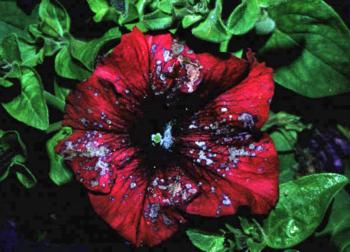Unused stories
Pest of the Month - Botrytis

When our long dry season is brought to an end with the wonderful first rains of the season, along with it comes the potential for Botrytis – the disease that can turn lush blooms into a brown, soggy mush. This ubiquitous disease is also know as Botrytis blight, bud rot, gray mold, wooly mold and when growing on grapes, the “noble rot” where it can either ruin a crop of grapes, or produce excellent dessert type wine. In our mild Mediterranean climate, we don’t see this disease too much during the dry summer months, but once the rains begin, the wooly gray fungus returns with a vengeance.
This garden bad guy has a wide range of host plants – from azaleas to cacti, coast redwood to fuchsias, hydrangeas, roses, and dahlias to name a few ornamental landscape plants. It also attacks food crops, notably grapes and berries. This nasty rot affects tender plant parts, weakened or injured, old or dead non-woody tissue. Once the fungus is established it can invade healthy green tissue.
The disease is caused by several strains of the fungus Botrytis cinerea and produces a range of effects. Flower petals become spotted or discolored, flower buds may fail to open or the buds may rot, leaves and shoots discolor, wilt, decay, and drop and twigs may die back. The symptomatic spots that look like water spots, start as tiny, almost translucent spots; they are caused by the plants’ reaction to the invasion of the fungus.
The disease thrives in warm, humid conditions; its optimal temperature range is 70° – 77°F, though it is active over a wide temperature range. The fungal spores can germinate and result in new infections after six or more consecutive hours in contact with free water – from splashing, condensation, or high relative humidity (greater than 90%). It survives in decaying plant material or on the soil surface and can overwinter even in cold climates. It can remain dormant until the weather conditions are right, then spring to life.
Since it is such a prevalent fungus, prevention is the best approach. When possible, choose plants that are not susceptible to the disease. Provide good cultural care to your plants and maintain your garden sanitation - clean up and dispose of fallen leaves and debris to minimize the reservoir for future infection. Prune out dead or dying tissue and thin the plant canopy to improve air circulation. Most importantly, avoid overhead watering, or if it is necessary, water in the morning so that plant surfaces have adequate time to dry.
Fungicides are generally not effective in environmental conditions that favor the disease (wet foliage), and are only preventive, not curative. Also, this disease is notorious for rapidly developing resistant strains, so if you spray, it is important to alternate spray materials.
By Nanette Londeree
